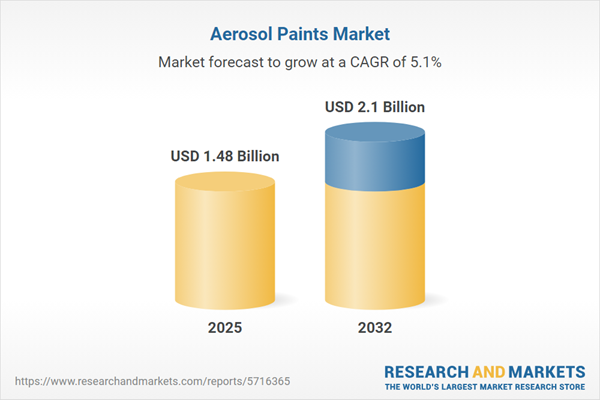Speak directly to the analyst to clarify any post sales queries you may have.
The aerosol paints market is at a pivotal juncture, shaped by accelerating sustainability demands, rapid advancements in digital technologies, and evolving end-user expectations. Senior executives navigating this landscape will find this market research essential for strategic planning and competitive differentiation.
Market Snapshot: Aerosol Paints Market Outlook
The aerosol paints market grew from USD 1.41 billion in 2024 to USD 1.48 billion in 2025, with expectations of reaching USD 2.10 billion by 2032 at a CAGR of 5.10%. This upward trajectory reflects robust demand across industrial, commercial, and consumer applications worldwide.
Scope & Segmentation
This research provides in-depth analysis of the global aerosol paints market, covering core technologies, market drivers, and regulatory influences. Market segmentation highlights:
- Applications: Aerospace coatings, automotive refinish (aftermarket and OEM), consumer and DIY (including arts & crafts, home décor, metal care, wood care), industrial maintenance (appliance coatings, electrical insulation and protective coatings), marine coatings, and wood furniture finishes.
- Distribution Channels: Hardware stores, mass merchandisers, specialty paint retailers, e-commerce marketplaces, and manufacturer websites.
- Propellant Types: Compressed gas, dimethyl ether, hydrocarbon propellants.
- Formulation Types: Solvent-based and water-based formulations.
- Price Points: Economy, mid-tier, and premium segments.
- Regions Covered: Americas (including United States, Canada, Mexico, Brazil, Argentina, Chile, Colombia, Peru), Europe, Middle East & Africa (with coverage of key countries such as United Kingdom, Germany, France, Russia, Italy, Spain, Netherlands, Sweden, Poland, Switzerland, United Arab Emirates, Saudi Arabia, Qatar, Turkey, Israel, South Africa, Nigeria, Egypt, Kenya), and Asia-Pacific (focused on China, India, Japan, Australia, South Korea, Indonesia, Thailand, Malaysia, Singapore, Taiwan).
- Competitive Landscape: Analysis of leading companies, including Akzo Nobel N.V., PPG Industries, The Sherwin-Williams Company, RPM International, BASF SE, Kansai Paint, Nippon Paint Holdings, Axalta Coating Systems, Jotun, and Hempel.
Key Takeaways: Strategic Insights for Stakeholders
- Sustainability is redefining formulation strategies, with increased emphasis on water-based and low-VOC options to align with environmental regulations and market sentiment.
- Digital tools, such as virtual color matching and e-commerce, are reshaping how products are specified, sourced, and purchased by both professional and DIY segments.
- Market access is evolving, as online channels and direct-to-consumer models expand reach and enable tailored offerings for niche and premium uses.
- Innovation in propellant technologies and rapid-cure resin chemistries is enabling differentiation in performance and safety profiles.
- Supply chain resilience, now an executive-level priority, is being addressed through regional sourcing, diversification, and strategic partnerships to manage input volatility.
- Regional dynamics, particularly regulatory frameworks in Europe and rapidly growing consumer bases in Asia-Pacific, are driving localized market adaptations and investment in new product platforms.
Tariff Impact: Navigating Supply Chain Challenges
The introduction of new United States tariffs on chemical feedstocks and propellant imports from 2025 has created cost pressures and sourcing complexities across the value chain. Leading manufacturers are mitigating these risks through dual strategies: building relationships with domestic suppliers and accelerating R&D into alternative and bio-based propellants. These actions have prompted a reevaluation of procurement and production models, with a focus on agility and efficiency to offset margin pressures.
Methodology & Data Sources
This report draws on a blended methodology that includes analysis of technical literature, market reports, patent filings, and regulatory databases. In addition, primary interviews with industry executives, procurement leads, and R&D directors were used to triangulate quantitative data and validate strategic insights through peer review and iterative data quality controls.
Why This Report Matters
- Enables data-backed decision-making for portfolio realignment and R&D prioritization in response to regulatory and technology shifts.
- Supports risk management through actionable insights on supply chain, tariff exposure, and market access strategies.
- Provides an analytical foundation for identifying high-growth application segments and regional expansion opportunities.
Conclusion
The aerosol paints market is undergoing rapid transformation, propelled by sustainability, digital enablement, and supply chain innovation. Decision-makers equipped with this research will be positioned to capture emerging opportunities and navigate evolving industry dynamics with confidence.
Additional Product Information:
- Purchase of this report includes 1 year online access with quarterly updates.
- This report can be updated on request. Please contact our Customer Experience team using the Ask a Question widget on our website.
Table of Contents
3. Executive Summary
4. Market Overview
7. Cumulative Impact of Artificial Intelligence 2025
Companies Mentioned
The companies profiled in this Aerosol Paints market report include:- Akzo Nobel N.V.
- PPG Industries, Inc.
- The Sherwin-Williams Company
- RPM International Inc.
- BASF SE
- Kansai Paint Co., Ltd.
- Nippon Paint Holdings Co., Ltd.
- Axalta Coating Systems Ltd.
- Jotun A/S
- Hempel A/S
Table Information
| Report Attribute | Details |
|---|---|
| No. of Pages | 180 |
| Published | November 2025 |
| Forecast Period | 2025 - 2032 |
| Estimated Market Value ( USD | $ 1.48 Billion |
| Forecasted Market Value ( USD | $ 2.1 Billion |
| Compound Annual Growth Rate | 5.1% |
| Regions Covered | Global |
| No. of Companies Mentioned | 11 |









